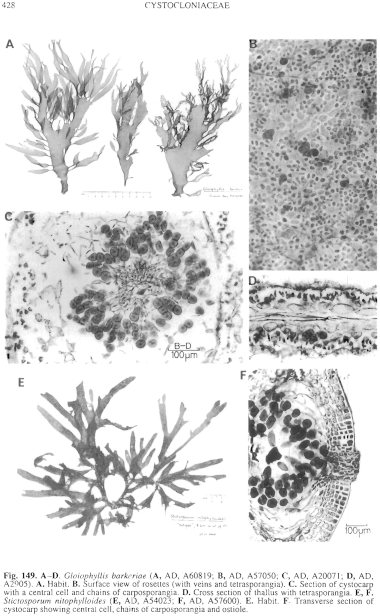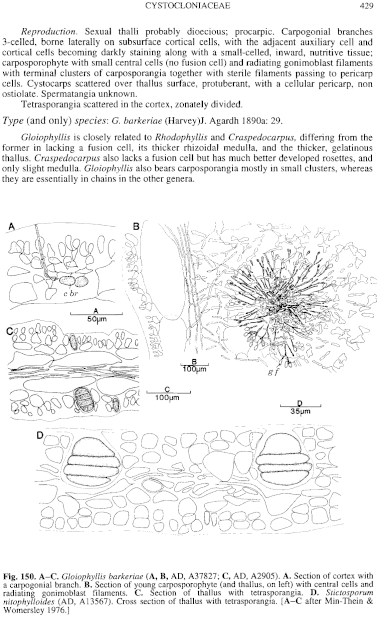|
|
|
|
|
|||||||||||
|
Electronic Flora of South Australia Species Fact Sheet
Phylum Rhodophyta – Class Florideophyceae – Order Gigartinales – Family Cystocloniaceae
Selected citations: De Toni 1897: 338. Fuhrer et al. 1981: pl. 19. Lucas 1929b: 49. Lucas & Perrin 1947: 164. May 1965: 407. Min-Thein & Womersley 1976: 125, figs 46, 67A. Papenfuss 1967: 101.
Synonyms
Rhodophyllis barkeriae Harvey 1863: pl. 276. J. Agardh 1876: 363.
Grunowiella barkeriae (Harvey) Schmitz 1889: 442 (nomen nudum). Kylin 1932: 43; 1956: 300. Schmitz & Hauptfleisch 1897: 375. Womersley 1950: 172.
Thallus (Fig. 149A) medium to dark red-brown, 10–40 (–50) cm high, gelatinous, complanately and irregularly furcately branched, often marginally proliferous, lower parts (0.5–) 1–3 (–5) cm broad and (200–) 300–800 µm thick, decreasing in width to 2–5 mm near the acute to rounded apices; margin smooth to undulate. Holdfast discoid, 1–5 mm across; epilithic. Structure uniaxial, with each axial cell cutting off alternately two periaxial cells, the lateral ones extending in the plane of the thallus, developing a cortex (Fig. 149D) of large ovoid cells 45–100 µm in diameter, with smaller ovoid outer cells 4–6 om across forming indistinct rosettes (Fig. 149B); medulla (Fig. 150C) thin, formed of axial and periaxial filaments (soon indistinct) and rhizoids from inner cortical cells. Rhodoplasts discoid to elongate, becoming ribbon shaped in inner cells.
Reproduction: Sexual thalli probably dioecious; procarpic. Carpogonial branches (Fig. 150A) 3-celled, borne on mid cortical cells, laterally orientated with reflexed trichogynes. Auxiliary cell adjacent outwardly to supporting cell, becoming darkly staining along with nearby cortical cells which also proliferate to form the pericarp; cells inward to the auxiliary cell cut off small darkly staining nutritive cells. Gonimoblast (Fig. 150B) compact, developing several central cells (often one more conspicuous - Fig. 149C), radiating gonimoblast filaments with chains of ovoid carposporangia 18–24 µm in diameter, and a few sterile filaments passing to the pericarp. Cystocarps scattered on the thallus surface, globular, often basally constricted, 750–1000 µm across, with a cellular pericarp, nonostiolate. Spermatangia unknown.
Tetrasporangia (Figs 149D, 150C) scattered in the cortex, pit-connected basally to laterally, ovoid, 20–45 µm in diameter, zonately divided.
Lectotype from Cape Shank, Vic. (Barker); in Herb. Harvey, TCD.
Selected specimens: Ward I., W of Flinders I., S. Aust., 18–23 m deep (Shepherd, 3.iii.1980; AD, A50911). "Hotspot", near Flinders I., S. Aust., 25 m deep (Branden, 23.i.1991; AD, A61228 -"Marine Algae of southern Australia" No. 353). Elliston, S. Aust., 7 m deep (Shepherd, 21.x.1970; AD, A37597). Vivonne Bay, Kangaroo I., S. Aust., drift (Womersley, 19.xii.1990; AD, A60819). Pennington Bay, Kangaroo I., S. Aust., drift (Womersley, 27.i.1946; AD, A2905). Stanley Beach, S coast, Kangaroo I., S. Aust., drift (Womersley, 7.ii.1956; AD, A20071). Nora Creina, S. Aust., drift (Womersley, 16.xii.1970; AD, A37827). Port Phillip Heads, Vic., 22 m deep outside Heads (Watson, 29.iii.1985; AD, A57050). Flinders, Western Port, Vic., drift (Sinkora A1719, 16.xi.1972; AD, A53429). Walkerville, Vic., drift (Sinkora A2074, 26.ii.1975; AD, A48420).
Distribution: Ward I., S. Aust., to Walkerville, Vic.
Taxonomic notes: Gloiophyllis barkeriae is a deep-water species found on rough water coasts.
References:
AGARDH, J.G. (1876). Species Genera et Ordines Algarum. Vol. 3, Part 1 - Epicrisis systematis Floridearum, pp. i-vii, 1–724. (Weigel: Leipzig.)
AGARDH, J.G. (1890a). Till algemes systematik. Acta Univ. lund. 26(3), 1–125, Plates 1–3.
DE TONI, G.B. (1897). Sylloge Algarum omnium hucusque Cognitarum. Vol. 4. Florideae. Sect. 1, pp. 1–388. (Padua.)
FUHRER, B., CHRISTIANSON, I.G., CLAYTON, M.N. & ALLENDER, B.M. (1981). Seaweeds of Australia. (Reed: Sydney.)
HARVEY, W.H. (1863). Phycologia Australica. Vol. 5, Plates 241–300, synop., pp. i-lxxiii. (Reeve: London.)
KYLIN, H. (1932). Die Florideenordnung Gigartinales. Lunds Univ. Årsskr. N.F. Avd. 2, 28 (8), 1–88, Plates 1–28.
KYLIN, H. (1956). Die Gattungen der Rhodophyceen. (Gleerups: Lund.)
LUCAS, A.H.S. & PERRIN, F. (1947). The Seaweeds of South Australia. Part 2. The Red Seaweeds. (Govt Printer: Adelaide.)
LUCAS, A.H.S. (1929b). A census of the marine algae of South Australia. Trans. R. Soc. S. Aust. 53, 45–53.
MAY, V. (1965). A census and key to the species of Rhodophyceae (red algae) recorded from Australia. Contr. N.S.W. natn. Herb. 3, 349–429.
MIN-THEIN, U. & WOMERSLEY, H.B.S. (1976). Studies on southern Australian taxa of Solieriaceae, Rhabdoniaceae and Rhodophyllidaceae (Rhodophyta). Aust. J. Bot. 24, 1–166.
PAPENFUSS, G.F. (1967). Notes on algal nomenclature. V. Various Chlorophyceae and Rhodophyceae. Phykos 5, 95–105.
SCHMITZ, F. & HAUPTFLEISCH, P. (1897). Gelidiaceae, Acrotylaceae, Gigartinaceae, Rhodophyllidaceae, Sphaerococcaceae, Rhodymeniaceae, pp. 340–405, Grateloupiaceae, Dumontiaceae, Nemastomaceae, Rhizophyllidaceae, Squamariaceae, pp. 508–537. In Engler, A. & Prantl, K., Die nattirlichen Pflanzenfamilien. T. 1. Abt. 2. (Engelmann: Leipzig.)
SCHMITZ, F. (1889). Systematische Uebersicht der bisher bekannten Gattungen der Florideen. Flora, Jena 72, 435–456, Plate 21.
WOMERSLEY, H.B.S. (1950). The marine algae of Kangaroo Island. III. List of Species 1. Trans. R. Soc. S. Aust. 73, 137–197.
The Marine Benthic Flora of Southern Australia Part IIIA complete list of references.
Publication:
Womersley, H.B.S. (14 January, 1994)
The Marine Benthic Flora of Southern Australia
Rhodophyta. Part IIIA, Bangiophyceae and Florideophyceae (to Gigartinales)
Reproduced with permission from The Marine Benthic Flora of Southern Australia Part IIIA 1994, by H.B.S. Womersley. Australian Biological Resources Study, Canberra. Copyright Commonwealth of Australia.
Illustrations in Womersley Part IIIA, 1994: FIGS 149 A–D, 150 A–C.

Figure 149 enlarge
Fig. 149. A–D. Gloiophyllis barkeriae (A, AD, A60819; B, AD, A57050; C, AD, A20071; D, AD, A2905). A. Habit. B. Surface view of rosettes (with veins and tetrasporangia). C. Section of cystocarp with a central cell and chains of carposporangia. D. Cross section of thallus with tetrasporangia. E, F. Stictosporum nitophylloides (E, AD, A54023; F, AD, A57600). E. Habit. F. Transverse section of cystocarp showing central cell, chains of carposporangia and ostiole.

Figure 150 enlarge
Fig. 150. A–C. Gloiophyllis barkeriae (A, B, AD, A37827; C, AD, A2905). A. Section of cortex with a carpogonial branch. B. Section of young carposporophyte (and thallus, on left) with central cells and radiating gonimoblast filaments. C. Section of thallus with tetrasporangia. D. Stictosporum nitophylloides (AD, A13567). Cross section of thallus with tetrasporangia. [A–C after MM-Thein & Womersley 1976.]

|
Email Contact: State Herbarium of South Australia |

|